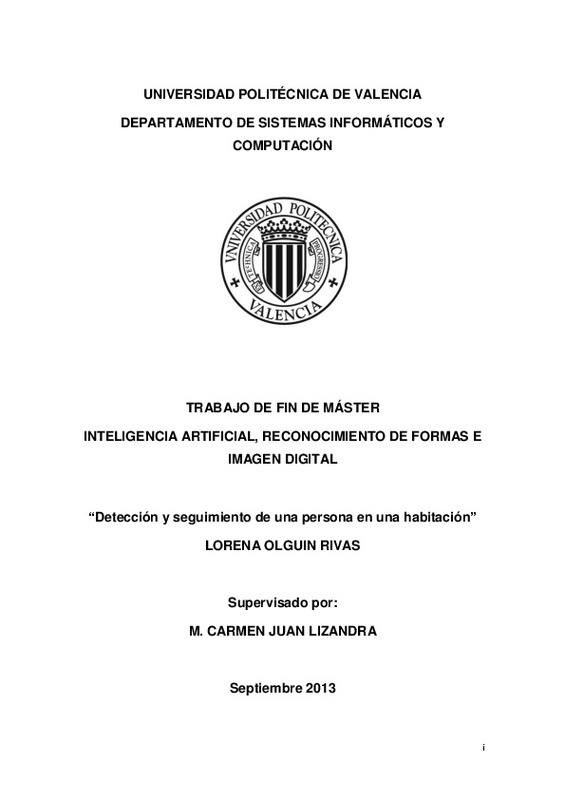JavaScript is disabled for your browser. Some features of this site may not work without it.
Buscar en RiuNet
Listar
Mi cuenta
Estadísticas
Ayuda RiuNet
Admin. UPV
Detección y seguimiento de una persona en una habitación
Mostrar el registro sencillo del ítem
Ficheros en el ítem
| dc.contributor.advisor | Juan Lizandra, María Carmen
|
es_ES |
| dc.contributor.author | Olguin Rivas, Lorena
|
es_ES |
| dc.date.accessioned | 2014-06-23T11:35:07Z | |
| dc.date.available | 2014-06-23T11:35:07Z | |
| dc.date.created | 2013-09-25 | |
| dc.date.issued | 2014-06-23 | |
| dc.identifier.uri | http://hdl.handle.net/10251/38278 | |
| dc.description.abstract | [ES] Existen diferentes métodos de detección de objetos utilizando diferentes dispositivos como cámaras web, Kinect, cámaras estereoscópicas, etc. La mayoría de estos estudios están enfocados a la detección de objetos con fines de seguridad en la sociedad, ya sea detectar robos, controlar el tráfico en las carreteras, contar personas en una escena, etc. Pero no existen sistemas para detectar alteraciones en el movimiento de las personas, o juegos para niños, pero con fines educativos. El presente trabajo final de Máster está motivado por la necesidad de seguimiento de una persona en una habitación para el proyecto CHILDMNEMOS. A lo largo de esta tesina se han desarrollado cuatro algoritmos con el fin de conseguir detectar a una persona en movimiento con dispositivos ubicados en el techo de una escena, de tal forma que detecte a la persona verticalmente y no de frente. Para ello se realizó un análisis de posibles algoritmos que podrían responder a nuestra necesidad utilizando dos dispositivos diferentes de captura de fotogramas de video; utilizamos una cámara Logitech 9000 y Kinect. Además de usar librerías para visión artificial y para el desarrollo de aplicaciones para Kinect. Estas librerías son OpenCV y OpenNI, respectivamente. Como pasos en los algoritmos desarrollados, se encuentran técnicas conocidas, como Sustracción de fondo, Mixture of Gauss, Filtro de Kalman; y también funciones de la librería OpenNI, que funcionan con Kinect. Se compararán los algoritmos y los dispositivos, para conocer qué algoritmo y qué dispositivo son los que ofrecen mejores resultados. Al realizar los experimentos, se obtuvieron mejores resultados con un algoritmo desarrollado para Kinect, usando la técnica que se planteó, que consiste en analizar solo una región de la escena capturada por Kinect (Cabeza y Hombros de la persona) el cual permitió sustraer el fondo; además de usar filtros para eliminar el ruido y sombra; y para el seguimiento se usó el Filtro de Kalman. | es_ES |
| dc.description.abstract | [EN] There are different methods for detecting objects using different devices such as web cameras, Kinect, stereoscopic cameras, etc. Most of these studies are focused on detection of objects for security in society, whether detect theft, monitor traffic on the roads, counting people in a scene, etc. But there aren¿t systems to detect changes in the movement of people, or children's games, but for educational purposes. This Thesis is motivated by the need to track a person in a room for the project CHILDMNEMOS. Throughout this thesis four algorithms have been developed in order to detect a person get moving with devices located in the ceiling of a scene, so the algorithms and the devices detects the person vertically and not in front of the person. This was achieved by an analysis of possible algorithms that could answer our need using two different devices capture video frames, we use a Logitech 9000 and Kinect camera. Besides using artificial vision and libraries for developing applications for Kinect. These libraries are OpenCV and OpenNI, respectively. As steps in the algorithms developed are known techniques such as background subtraction, Mixture of Gauss, Kalman Filter, and OpenNI library functions that work with Kinect. Will compare the algorithms and devices for which algorithm and which device are those that offer better results. In conducting the experiments, better results were obtained with an algorithm developed for Kinect, using the technique proposed, which consists of analyzing only a region of the scene captured by Kinect (Head and shoulders of the person) which allowed background subtraction in addition to using filters to remove noise and shadow, and for Tracking Kalman filter was used. | es_ES |
| dc.format.extent | 110 | es_ES |
| dc.language | Español | es_ES |
| dc.publisher | Universitat Politècnica de València | es_ES |
| dc.rights | Reconocimiento - No comercial - Sin obra derivada (by-nc-nd) | es_ES |
| dc.subject | Detección de personas | es_ES |
| dc.subject | Seguimiento | es_ES |
| dc.subject | Mezcla de Gaussianas | es_ES |
| dc.subject | Filtro de Kalman | es_ES |
| dc.subject | OpenNI | es_ES |
| dc.subject | Detection of people | es_ES |
| dc.subject | Tracking | es_ES |
| dc.subject | Mixture of Gaussian | es_ES |
| dc.subject | Kalman Filter | es_ES |
| dc.subject.classification | LENGUAJES Y SISTEMAS INFORMATICOS | es_ES |
| dc.subject.other | Máster Universitario en Inteligencia Artificial, Reconocimiento de Formas e Imagen Digital-Màster Universitari en Intel·Ligència Artificial: Reconeixement de Formes i Imatge Digital | es_ES |
| dc.title | Detección y seguimiento de una persona en una habitación | es_ES |
| dc.type | Tesis de máster | es_ES |
| dc.rights.accessRights | Abierto | es_ES |
| dc.contributor.affiliation | Universitat Politècnica de València. Servicio de Alumnado - Servei d'Alumnat | es_ES |
| dc.description.bibliographicCitation | Olguin Rivas, L. (2013). Detección y seguimiento de una persona en una habitación. http://hdl.handle.net/10251/38278 | es_ES |
| dc.description.accrualMethod | Archivo delegado | es_ES |






